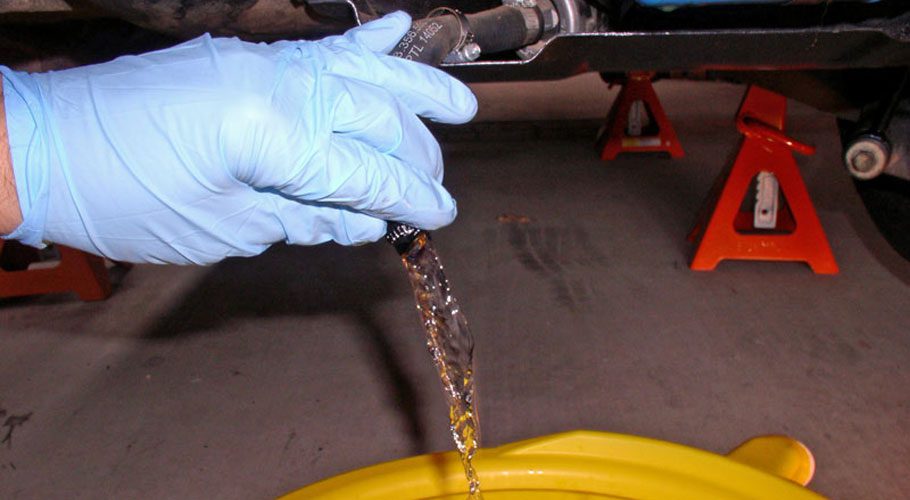
How to remove water from a car gas tank easily and easily
Content
The ingress of water into the fuel system of a car can lead to breakage of one of its parts, and engine performance will significantly decrease. Everything, of course, depends on the amount of foreign liquid in the tank.
We will discuss how to determine that water has entered the fuel tank of a car, as well as how to remove it from there.
How water enters the gas tank
Before figuring out how to remove water from a car's tank, you should understand how it gets there if the driver never refills the car at bad gas stations, and always closes the lid tightly.
The very first reason for the appearance of moisture in the tank is condensation on its walls. It often forms when temperature changes are periodically observed outside. Or this effect occurs in cars stored in warm garages. Moreover, the less fuel is in the tank, the more moisture will accumulate on its walls. Large enough droplets run down.
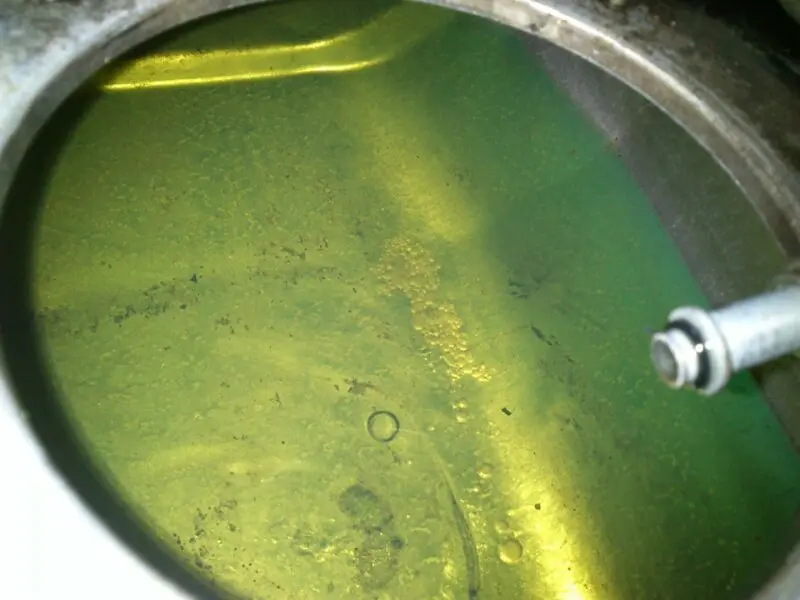
Since gasoline has a lower density than water, it will always be at the very bottom of the tank. There is also a fuel pump branch pipe. Therefore, even if there is still enough gasoline in the tank, water will be sucked in first.
For this reason, drivers are advised to refuel not in five liters, but as much as possible. If in the summer the moisture in the fuel supply system only affects the dynamic characteristics of the engine, then in the winter the droplets can crystallize and block the line. If the crystals are small, they will fall into the fuel filter and, with their sharp edges, can tear the filter material.
Poor quality fuel is another reason moisture can get into the gas tank. The material itself can be quite good, only because of the negligence of the workers, a large amount of condensate could accumulate in the station's tank. For this reason, it is worth refueling only at those gas stations that have proven themselves.
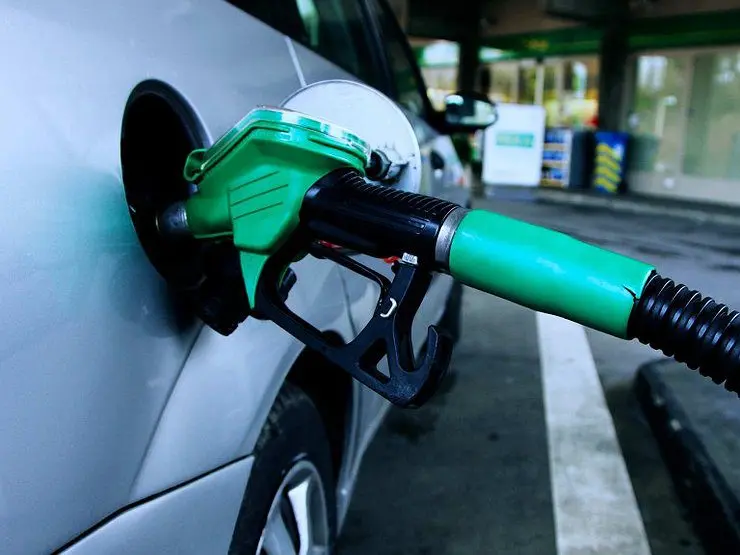
But what if the gasoline in the tank runs out, but it is still far from the normal station? An old trick will help with this - always carry a 5-liter can of fuel with you in the trunk. Then there will be no need to refuel with low-quality fuel.
How do you know if there is water in the gas tank?
The very first sign by which you can find out about the presence of water in the gas tank is the unstable operation of the internal combustion engine, provided that all its systems are in good order. This is especially true when the car has been idle for a long time. When the driver tries to start the engine in such a situation, the unit starts up with difficulty, and stalls in the first minutes of operation.
The second signal, indicating the presence of foreign liquid, is the occurrence of shocks in the motor. If water gets into the fuel system, the crankshaft will knock, which will be clearly audible in the passenger compartment. When the unit warms up, this effect disappears.
How and how to get rid of water in a gas tank?
There are two ways to remove unwanted liquid from a car's gas tank:
- With the help of improvised means and dismantling;
- With the help of auto chemistry.
In the first case, you can remove the tank and drain all its contents. Since the water will be at the bottom, the top liquid ball can be reused and the rest will need to be removed. Of course, this method is the most time consuming, as it requires sufficient time. But by dismantling the tank, you can be 100 percent sure that there is no water left in it.
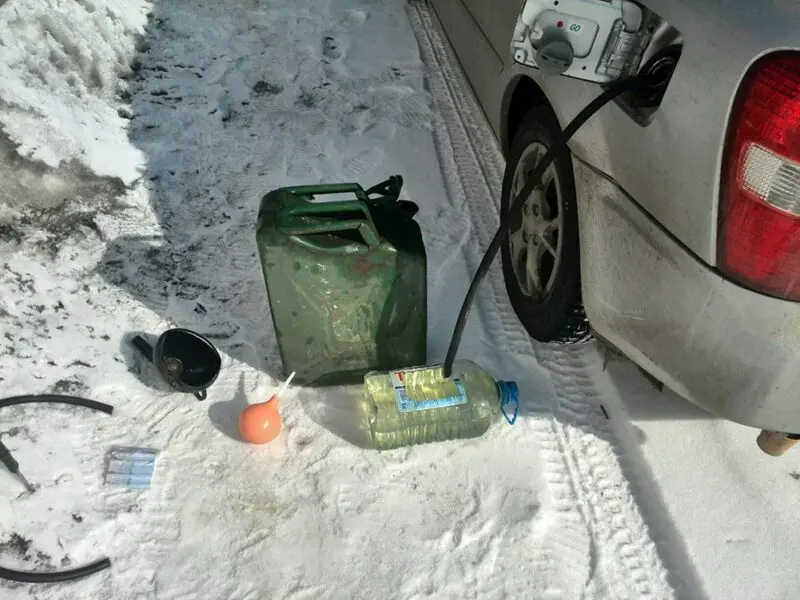
Another method is to drain the entire contents of the tank without dismantling. To do this, you can use a hose and canister. Several variants of such a procedure are described in detail. in a separate review.
The third method of mechanical moisture removal is suitable for injection vehicles. First, we disconnect the fuel hose coming out of the pump, connect another analogue to the fitting. Place the free edge in a bottle or other container. When the key is turned in the ignition lock, the pump starts pumping liquid. Given that the water is at the bottom of the tank, it will be removed quickly enough.
The rest of the methods should be given a little more attention, since few drivers want to tinker with their car. For them, it is better to pour something into the tank so that the water goes somewhere on its own.
Removing water using special products
Unfortunately, not all car problems are solved in a similar way, but the water in the gas tank can be dealt with with the help of auto chemistry. It is worth considering that this method does not remove water, but allows you to quickly remove it from the system.
Here are some tools to help you deal with this problem:
- Alcohol in gasoline. In this case, the tank should be more than half full of fuel. Pour liquid directly through the neck of the tank. It will take from 200 to 500 milliliters. The effect of the procedure is as follows. Water reacts with alcohol and mixes with fuel. The mixture burns along with the main portion of the fuel, without causing as much harm as if only moisture were sucked into the line. This work should be carried out before the onset of frost and after winter. It is better to fully develop the volume, and only then fill with a new volume of fuel. Before filling in fresh gasoline, we change the fuel filter, as the procedure can raise sediment from the bottom of the tank.

- Manufacturers of chemicals for cars have developed special additives that are also added to the tank. In order not to damage the fuel system or internal combustion engine, you should carefully read how to use a particular product.
As for additives, they are divided into several categories:
- Dehydrating properties. These agents do not remove water in the tank, but prevent it from crystallizing in the system.
- Cleansing. They remove carbon deposits and deposits from the walls of the entire line, including from cylinders, valves and pistons. They help to save some fuel.
- Stabilizers for diesel fuel. These substances reduce the viscosity of the fuel in cold weather, preventing gel formation.
- Restorative substances. Most often they are used by car owners of vehicles with high mileage. They allow to slightly restore damaged surfaces of cylinders and pistons.
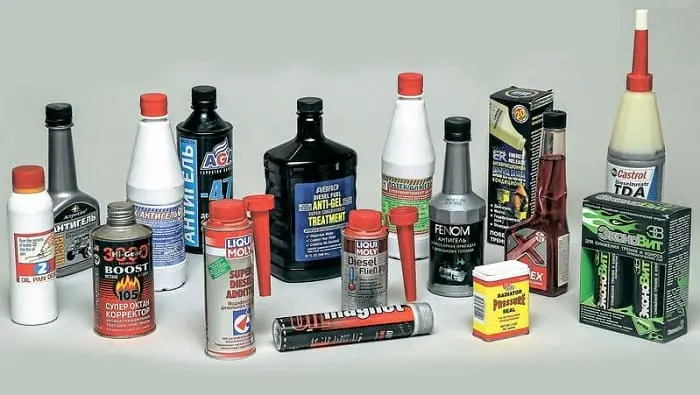
Every motorist has his own opinion about the use of additives. The reason is that not every unit adequately perceives third-party chemicals.
Major brands of water removal additives
If you decide to use one of the water removal additives, then here is a small list of the most popular remedies:
- Many motorists speak positively of the ER-labeled additive. The substance reduces friction between engine parts, which reduces the load, slightly increasing the torque. The powertrain becomes quieter. Most often this tool is used by owners of cars with decent mileage.
- Effective "dehumidifier", which has established itself as a quality tool that removes extraneous moisture directly from the tank - 3TON. One bottle is enough to remove 26 ml of water. The additive is also used to clean the walls of the gas tank. After using the product, it is better to replace the fuel filter and clean the coarse filter on the gasoline pump.
- Cera Tec by Liqui Molly. This tool belongs to the category of reducing agents. The substance contains revitalizants that can eliminate microscopic scratches on the cylinder surface, reducing oil consumption and slightly increasing compression. It reacts with moisture, quickly removing it from the fuel system, preventing liquid from accumulating in the tank. This tool is the most expensive from the above list.
- The following product was created for light trucks and passenger cars, the engine volume of which does not exceed 2,5 liters. It is called "Suprotek-Universal 100". The substance stabilizes engine speed, reduces oil and fuel consumption. The most significant drawback is the high cost. It is also recommended to use it if the mileage of the car is more than 200 thousand.
- The most budgetary analogue of such funds is STP. One container of the substance allows you to remove about 20 milliliters of moisture from the tank. Since there is no alcohol in its composition, the additive does not always effectively cope with its function.
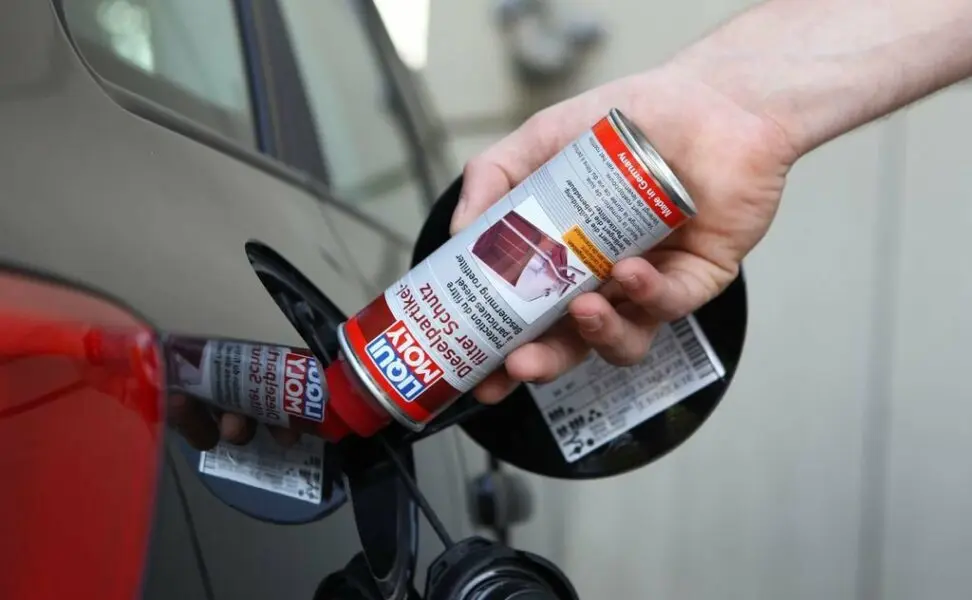
Ways to prevent water from entering the gas tank
As the saying goes, it is better to prevent than to cure, so it is better to ensure that no water gets into the tank at all than to use auto chemistry later. Here are some simple tips to help keep condensation out of your fuel system:
- Refuel only at familiar gas stations that always sell high-quality fuel;
- Do not fill the car with a small amount of gasoline, and do not open the tank cap unnecessarily;
- If the weather outside is damp (foggy autumn or seasonal showers), it is better to fill the tank to full volume, and it is better to do this in the evening, and not in the morning, when condensation has already appeared in the tank;
- With the onset of the wet season, about 200 g of alcohol can be added to the tank for the sake of prevention;
- Timely replacement of the fuel filter is an equally important preventive procedure;
- Before the onset of winter, some car owners completely develop gasoline from the tank, dry it completely, and then fill in the full volume of fuel.
Prevention of the appearance of water in the gas tank
Experienced motorists always try to keep the tank as full as possible. Due to this, if condensation appears the next morning, then it will be a small amount. If the car needs to be refueled when it is foggy or rainy outside, then the tank should be filled to the brim so that the moist air would be forced out by the incoming volume of fuel.
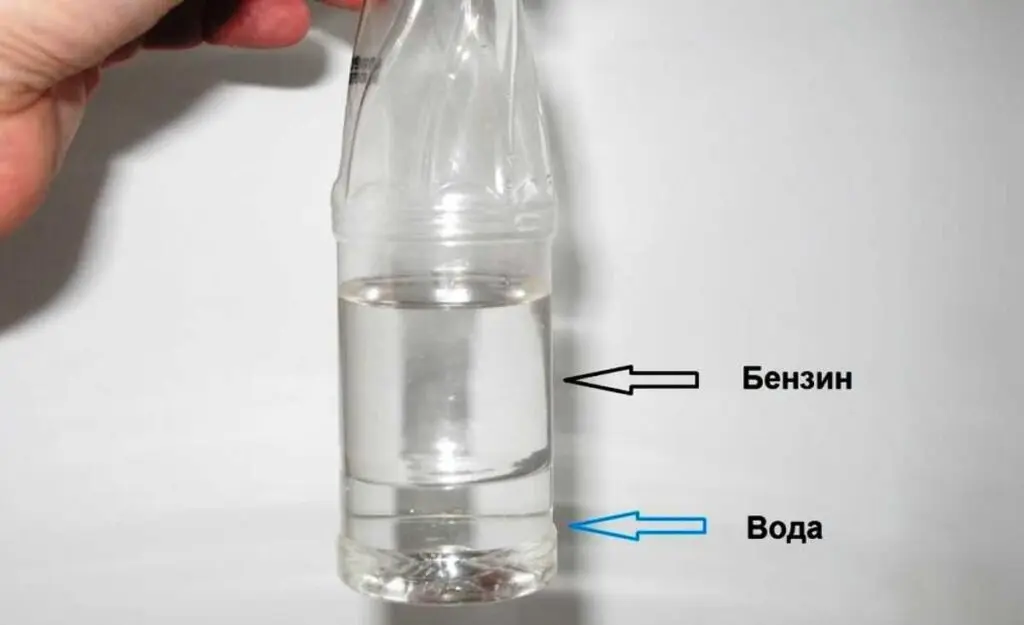
It is difficult to protect yourself from ill-wishers-vandals, so a cap with a code or a key can be installed on the neck of the gas tank. So those who like to damage other people's cars will not be able to pour water into the tank.
And finally: a preventive procedure for removing moisture from the fuel tank is better in spring, since a small amount of moisture will still appear in a half-empty tank during the winter. This will prevent the engine from premature failure.
Questions and answers:
How to remove water from the diesel fuel system? The most common method is to install a filter with a sump. Water from the reservoir, depending on the modification of the filter, can be removed manually or automatically.
How to remove condensate from a gas tank? Ethyl alcohol mixes well with water (vodka is obtained). With the onset of autumn, you can add about 200 grams to the gas tank. alcohol, and the resulting mixture will burn with gasoline.
How can you separate water from gasoline? In winter, in the cold, a piece of reinforcement is inserted into an empty canister. Gasoline is poured in a thin stream from above onto the frozen metal. The water from the fuel will freeze to the metal, and the gasoline will drain into the canister.



One comment
anonym
Strange Swedish …… difficult to trust.